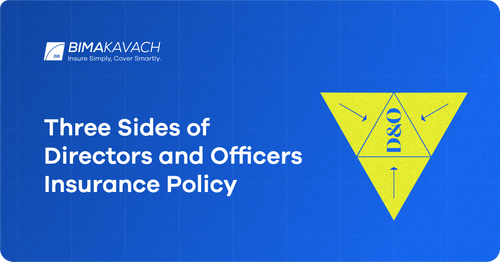The D&O Insurance is a policy designed to cover the potential legal liabilities of directors, board members, and other employees in a management/supervisory capacity-in case they get indicted over the decisions taken by them for running the company. This insurance cover protects the personal assets of the directors and officers and the company as well. It compensates them for settlements and legal expenses resulting from such suits and litigations.
Three sides of D&O Insurance
There are 3 sides to D&O insurance - Side A, Side B and Side C. An organization can opt for anyone, depending on its needs, business model, and financial position.
- Side A Coverage
Side A coverage protects the directors and officers against financial liabilities in case the organisation refuses to or is unable to come to its rescue. Here, the individual director or officer is insured and his personal assets are at risk.
Side A coverage is designed to fill the gap in coverage that may exist under traditional corporate liability policies, which may not provide coverage for individual directors and officers. With Side A coverage, individual directors and officers are protected against financial losses that may result from a lawsuit or legal action, regardless of whether the company has the resources to pay for legal defence costs or pay damages.
Side A coverage is typically offered as part of a D&O insurance policy, which provides broader protection for directors, officers (the insured person) and the company itself. It is important to understand the terms and conditions of a D&O insurance policy, including any limitations or exclusions, to ensure that individual directors and officers have the coverage they need to protect their personal assets.
Here is an example of how Side A coverage in a Directors and Officers (D&O) insurance policy might work:
Imagine that the CEO of an Indian company is sued for making false statements in a press release that led to a drop in the company's stock price. The CEO is held personally liable for the damages suffered by shareholders and is required to pay compensation to them. In this scenario, Side A coverage under the CEO's D&O insurance policy would come into play. The policy would provide coverage for the CEO's personal financial loss, including the costs of defending the lawsuit and any compensation paid to the shareholders.
Get Free Quote in Minutes
- Side B Coverage
Side B Coverage in Directors and Officers Insurance Policy provides coverage for losses that the company (or organization) incurs as a result of paying for damages and defence costs for claims brought against its directors and officers. In other words, Side B coverage provides reimbursement to the company for the costs it has incurred in defence of its directors and officers. Here, the organisation is insured and its corporate assets are at risk. This is in contrast to Side A coverage, which provides coverage for the directors and officers themselves, in the event that they are personally liable for damages.
D&O insurance policies typically include Side A and Side B coverage and are designed to protect directors and officers from personal financial loss, as well as to protect the company from the costs of defending and indemnifying them.
Here is an example of how Side B coverage in a Directors and Officers (D&O) insurance policy might work:
Imagine the board of directors of a private company is sued by a former employee who alleges that she was wrongfully terminated . In the lawsuit she has claimed damages for lost wages, emotional distress, and other related costs.
The Side B coverage of the policy will pay the costs incurred by the company while legally defending its directors, in paying settlements to third parties on behalf of its directors and other costs such as the cost of hiring public relations consultants to manage any negative publicity that may result from the lawsuit. The company can claim reimbursements of such costs under the Side B cover and the insurer would indemnify the company for the financial loss suffered.
- Side C Coverage
The Side C coverage in a Directors and Officers (D&O) liability insurance policy covers claims made against the company for violations of securities laws. It is also referred to as entity coverage .
Side C coverage is important because it provides protection for the company itself. In the event of a securities law violation claim, it can help to protect the company's assets and financial stability. For example, if the shareholders file a lawsuit against the company for anything related to the securities that were traded on the stock exchange, the Side C cover would indemnify the company for the legal expenses incurred.
D&O insurance policies typically include both Side A, Side B, and Side C coverage, and are designed to protect directors and officers from personal financial loss, as well as to protect the company from the costs of defending and indemnifying them and from losses arising from claims brought against it.
Here is an example of how Side C coverage in a Directors and Officers (D&O) insurance policy might work:
Imagine that a shareholder of an Indian company sues the company for losses suffered as a result of false statements made by the company's directors and officers in a press release. The company incurs substantial costs in defending itself against the lawsuit, including legal fees and other expenses. In this scenario, Side C coverage under the company's D&O insurance policy would come into play. The policy would provide coverage for the costs incurred by the company in defence of the lawsuit, including legal fees, expert witness fees, and other related expenses.
The footnote:
It is important to note that D&O insurance is not a guarantee of protection from financial loss, and coverage may be limited by policy exclusions and limitations. Here you got to know the DnO meaning, the three sides of D&O policy, and when directors become personally liable in India.

